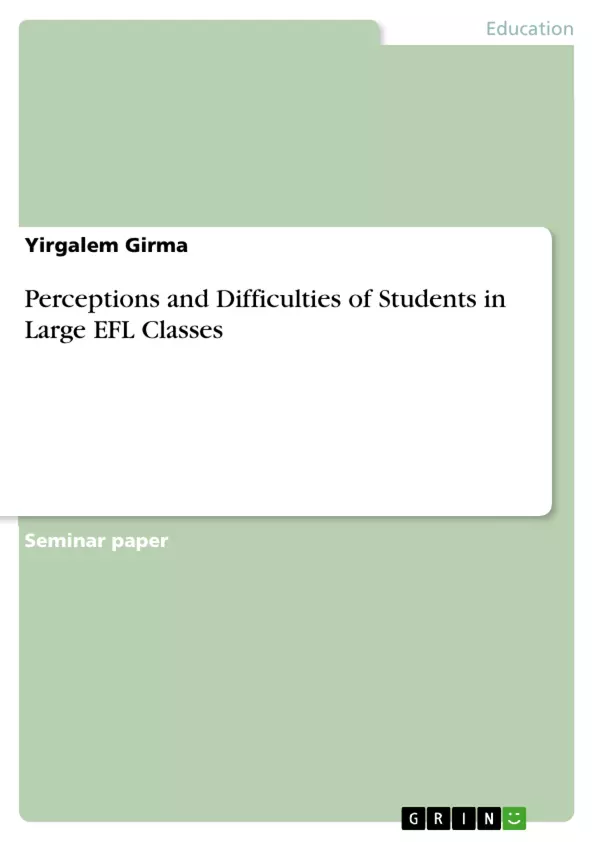This study was aimed at assessing students' perceptions of large EFL class in terms of the instructional, psychological and social aspects and perceived challenges. The study adopted the descriptive research approach. Two preparatory schools were selected owing to their convenience and the serious situational constraints in teaching large EFL large classes Ethiopia. The data were collected using likert-scale questionnaires and semi-structured interviews. Eight randomly selected EFL teachers filed open-ended and close-ended questionnaire. Out of 1545, 155 students were selected using simple random sampling technique. Ten students were voluntarily selected and interviewed. The quantitative data were analyzed through descriptive statistics, but qualitative data gathered via interview were analyzed descriptively. The findings showed that most participants had clear picture of the situational challenges and benefits of EFL large class. The majority of the respondents' perceived the instructional and psychological aspects negatively, but the social aspects favorably. The EFL teachers and most students perceived that learning in EFL large class affects English learning outcomes and large EFL class matters beyond quality of instructions. The perceived difficulties of large EFL class were: lack of continuous assessment, getting immediate feedback to students, avoidance of writing and speaking, focusing on usage, low active involvement, less students learning, lack of rapport, no use of teaching aids, teachers’ failure active learning and motivational strategies, lack of motivation, concentration, confidence and student-teacher interaction. The constraints can be alleviated using effective instructional strategies, class size reduction, and training competent and potential EFL teachers, and working flexibly and cooperatively with students.
Inhaltsverzeichnis (Table of Contents)
- Chapter One: Introduction.
- 1.1.Background of the Study.
- 1.2. Statement of the Problem.....
- 1.3 Objectives of the Study......
- 1.4. Significance of the Study
- 1.5. Scope of the Study…………………………..\n
- 1.6. Limitations of the Study..\n
- 1.7. Organization of the Study..\n
- Chapter Two: Review of Related Literature......
- 2.1. Definition and Nature of Large Class
- 2.2. The Class Size Debate
- 2.3. Problems of Large Class Size........
- 2.3.1 Problems of Students' Active Involvement in Large Class
- 2.3.2 Assessment and Feedback Problems in Large Class
- 2.3.3. Problems of Large Class Management........
- 2.3.4. Affective Challenges in Large Class......
- 2.3.5. Resource Related Constraints….......
- 2.4. The Impacts of Large Class Size.
- 2.4.1. Impact of Large Class on Teachers......
- 2.5. Students View in Large Class.
- 2.6. Local studies on large class size.
- 2.7. Some Strategies to Cope up with Large Class
- 2.7.1 Instructional Strategies for Improving Problems of Large class.
- 2.7.2. Use of Good Rapport in Large Class
- 2.7.3. Solving Management Problems in Large Class….......
- 2.8. Group Work and Large Class
- 2.9. Motivation for Learning and Large Class
- 2.10. The Physical Classroom Environment...
- 2.11. Benefits of Large Class ....
- Chapter Three: Research Methodology.
- 3.1 Research Design.
- 3.2 Description of the Study Setting….......
- 3.3. Data Type and Source
- 3.4 Sampling
- 3.4.1 Sampling Frame and Size......
- 3.4.2. Sampling Techniques ....
- 3.4.3 Sampling Procedure
- 3.5 Data Gathering Instruments.
- 3.5.1 The Questionnaire
- 3.5.2 Interview
- 3.6 Data Collection Procedure...........
- 3.6.1 Pilot Testing..\n
- 3.6.2 Main Study
- 3. 7. Methods of Data Analysis.........
- Chapter Four:Data Presentations, Analysis and Discussions
- 4.1. Background Information...........
- 4.2.Participants Response to Class Size.
- 4.3 Analysis of Teachers Questionnaire..........\n
- 4.4. Analysis of Students Questionnaires.………………
- 4.5. Brief Discussions on Results of the Students Questionnaire
- 4.6. Analysis of Students Interview
- 4.7. Discussions on the Results of the Interview.
- Chapter Five: Summary, Conclusions and Recommendations...
- 5.1. Summary of the Key Findings
- 5.2. Conclusions
- 5.3. Recommendations
Zielsetzung und Themenschwerpunkte (Objectives and Key Themes)
This study aims to assess the perceptions of students towards large English as a Foreign Language (EFL) classes in Ethiopian preparatory schools, analyzing their views on the instructional, psychological, and social aspects of such classes. The study also aims to identify and understand the challenges students face in these large classes.
- Student perceptions of large EFL classes.
- The impact of large class size on learning.
- The challenges and difficulties faced by students in large EFL classes.
- Effective strategies for coping with large EFL classes.
- The role of teacher training and support in addressing the challenges of large classes.
Zusammenfassung der Kapitel (Chapter Summaries)
Chapter One provides an introduction to the study, outlining the background, problem statement, objectives, significance, scope, limitations, and organization of the research.
Chapter Two presents a comprehensive review of related literature, focusing on the definition and nature of large classes, the class size debate, problems associated with large class sizes, their impacts on students and teachers, and various strategies for coping with large classes.
Chapter Three details the research methodology, describing the research design, study setting, data type and source, sampling techniques, data gathering instruments, data collection procedure, and methods of data analysis.
Chapter Four presents the results of the study, analyzing data collected from student and teacher questionnaires and interviews. The findings reveal student perceptions of large classes, challenges faced, and the effectiveness of different strategies for coping with such situations.
Schlüsselwörter (Keywords)
The study revolves around the key concepts of large EFL classes, student perceptions, instructional challenges, psychological and social impacts, learning difficulties, and effective strategies for coping with large classes. It also considers the role of teacher training, class size reduction, and the use of appropriate teaching strategies in addressing the challenges associated with large EFL classes.
- Quote paper
- Yirgalem Girma (Author), 2023, Perceptions and Difficulties of Students in Large EFL Classes, Munich, GRIN Verlag, https://www.hausarbeiten.de/document/1337168


